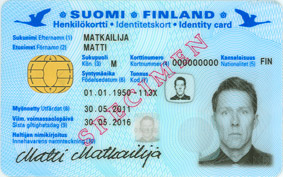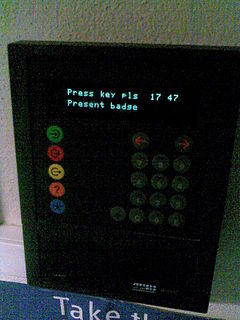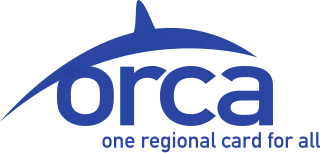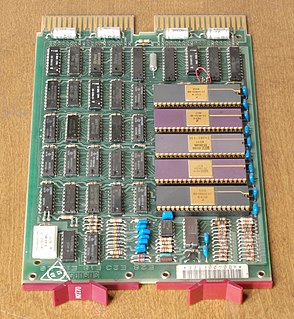
A smart card, chip card, or integrated circuit card (ICC) is a physical electronic authorization device, used to control access to a resource. It is typically a plastic credit card sized card with an embedded integrated circuit. Many smart cards include a pattern of metal contacts to electrically connect to the internal chip. Others are contactless, and some are both. Smart cards can provide personal identification, authentication, data storage, and application processing. Applications include identification, financial, mobile phones (SIM), public transit, computer security, schools, and healthcare. Smart cards may provide strong security authentication for single sign-on (SSO) within organizations. Several nations have deployed smart cards throughout their populations.
Seismic risk refers to the risk of damage from earthquake to a building, system, or other entity. Seismic risk has been defined, for most management purposes, as the potential economic, social and environmental consequences of hazardous events that may occur in a specified period of time. A building located in a region of high seismic hazard is at lower risk if it is built to sound seismic engineering principles. On the other hand, a building located in a region with a history of minor seismicity, in a brick building located on fill subject to liquifaction can be as high or higher risk.
Specific Area Message Encoding (SAME) is the protocol used to encode the Emergency Alert System (EAS) and NOAA Weather Radio (NWR) in the U.S. and Weatheradio Canada in Canada. It is also used to set off receivers in Mexico City and surrounding areas as part of the Mexican Seismic Alert System (SASMEX).

A call box or callbox is a box containing a special-purpose direct line telephone or other telecommunications device, which has been used by various industries and institutions as a way for employees or clients at a remote location to contact a central dispatch office.

A time clock, sometimes known as a clock card machine or punch clock or time recorder, is a device that records start and end times for hourly employees at a place of business.

A paycheck, also spelled pay check or pay cheque, is traditionally a paper document issued by an employer to pay an employee for services rendered. In recent times, the physical paycheck has been increasingly replaced by electronic direct deposits to the employee's designated bank account or loaded onto a payroll card. Employees may still receive a pay slip to detail the calculations of the final payment amount.
An information security audit is an audit on the level of information security in an organization. Within the broad scope of auditing information security there are multiple types of audits, multiple objectives for different audits, etc. Most commonly the controls being audited can be categorized to technical, physical and administrative. Auditing information security covers topics from auditing the physical security of data centers to auditing the logical security of databases and highlights key components to look for and different methods for auditing these areas.

The Robert T. Stafford Disaster Relief and Emergency Assistance Act is a United States federal law designed to bring an orderly and systemic means of federal natural disaster assistance for state and local governments in carrying out their responsibilities to aid citizens. Congress's intention was to encourage states and localities to develop comprehensive disaster preparedness plans, prepare for better intergovernmental coordination in the face of a disaster, encourage the use of insurance coverage, and provide federal assistance programs for losses due to a disaster.

Hazus is a geographic information system-based natural hazard analysis tool developed and freely distributed by the Federal Emergency Management Agency (FEMA).

The ORCA card is a contactless, stored-value smart card system for public transit in the Puget Sound region of Washington, United States. The card is valid on most transit systems in the Seattle metropolitan area, including Sound Transit, local bus agencies, Washington State Ferries, the King County Water Taxi, and Kitsap Fast Ferries. It was launched in 2009 and is managed by the Central Puget Sound Regional Fare Coordination Project, a board composed of local transit agencies.
In the fields of computer security and information technology, computer security incident management involves the monitoring and detection of security events on a computer or computer network, and the execution of proper responses to those events. Computer security incident management is a specialized form of incident management, the primary purpose of which is the development of a well understood and predictable response to damaging events and computer intrusions.
ISO/IEC 27002 is an information security standard published by the International Organization for Standardization (ISO) and by the International Electrotechnical Commission (IEC), titled Information technology – Security techniques – Code of practice for information security controls.

The Oklahoma Department of Emergency Management (OEM) is a department of the government of Oklahoma responsible for coordinating the response to a natural disaster that has occurred in the State and that has overwhelmed the abilities of local authorities. This is achieved primarily through the development and maintenance of a comprehensive statewide emergency management plan. OEM is responsible for coordinating the efforts of the federal government with other state departments and agencies, county and municipal governments and school boards, and with private agencies that have a role in emergency management.
A second responder is a worker who supports "first responders" such as police, fire, and emergency medical personnel. They are involved in preparing, managing, returning services, and cleaning up sites during and after an event requiring first responders. These sites may include crime scenes and areas damaged by fire, storm, wind, floods, earthquakes, or other natural disasters. These types of services may include utility services, wireless (3G/4G/WiFi) or wireline communication services, specialty construction, hazardous waste cleanup, road clearing, crowd control, emergency services, first aid, food services, security services, social services, and sanitation.
In the United States, a cityidentification card is a form of identification card issued by a municipality, such as a city, rather than a state or federal government. Under federal law, cities may issue their own identification cards as they see fit, and do not have to consider the immigration or criminal status of an applicant before doing so. New Haven, Connecticut issued the first municipal identification cards in the United States, the Elm City Resident Card, in 2007. On January 15, 2009, the city/county of San Francisco launched the SF City ID Card, a municipal identification card program modeled after New Haven's. Other cities that issue identification cards include Asbury Park, New Jersey, and Washington, D.C.. In Mercer County, New Jersey, a community ID card is being issued by a local non profit organization with the endorsement of various law enforcement agencies.
The California Governor's Office of Emergency Services (CalOES) is a California cabinet-level agency responsible for overseeing and coordinating emergency preparedness, response, recovery and homeland security activities within the state. The agency was created by AB 38 (2008), superseding both the Office of Emergency Services (OES) and Office of Homeland Security (OHS).
The Stephenson Disaster Management Institute at Louisiana State University is located in the Stephenson National Center for Security Research and Training at LSU.
The SF City ID Card is a municipal identification card program operated by San Francisco, California for residents of the city-county, regardless of their immigration status. The cards also do not specify the person's gender, to assist transgender individuals who often have difficulty with identification documents.

Due to the common occurrence of hurricanes in the coastal state of North Carolina, hurricane recovery in North Carolina is a large component of the state's emergency management efforts. Recovery from these tremendous storms at the local and state level is a large part of the aftermath of a hurricane. Gavin Smith and Victor Flatt stated that "Disaster recovery remains the least understood aspect of hazards management, when assessed relative to preparedness, response, and hazard mitigation." Smith and Flatt also went on to state that the role of the states is even less understood. The review of the plans and policies that instruct recovery, agencies involved, funding processes and budgets, and the environmental effects of a hurricane creates a better understanding of how North Carolina recovers from a hurricane.

Wildfires are outdoor fires that occur in the wilderness or other vast spaces. Other common names associated with wildfires are brushfire and forest fire. Since wildfires can occur anywhere on the planet, except for Antarctica, they pose a threat to civilizations and wildlife alike. In terms of emergency management, wildfires can be particularly devastating. Given their ability to destroy large areas of entire ecosystems, there must be a contingency plan in effect to be as prepared as possible in case of a wildfire and to be adequately prepared to handle the aftermath of one as well.














